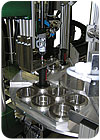
For a line of anti-vibration grinding-machine grips it manufactures in the Czech Republic, Robert Bosch Group needed to assemble each handle using a screw with a 3-millimeter standoff height to ensure effective spring action of the grip. Bosch also needed to assemble the grips vertically, from the top down, with a cycle time of less than 10 seconds per grip.
To ensure product quality, Bosch wanted an automated system that would confirm the presence of the screws in the finished assemblies and shunt any defects into a reject bin. In addition, the machine had to be flexible enough to accommodate the two different screw sizes that went into two slightly different grip models.
To meet these goals, Bosch installed an automated screwdriving system built by screwdriving and automation company DEPRAG (Lewisville, TX). The machine includes a single-spindle screwdriving unit and a rotary index table with four positions. The table is equipped with four nests, each with fixturing for six grips.
Specific components include a 310E36-018 EC-Screwdriver spindle with combined torque and angle transducer; a model 0511-EP/2,5-1 screwfeeding machine combined with a belt-driven B10 hopper; an AST30 sequence controller; and a battery of sensors that help regulate load-position and depth-control, as well as screwdriver and cylinder stroke.
The machine also employs a DEPRAG LC2plus controller, a TP1plus operator display and light curtains for operator safety.
To begin the assembly sequence at the first station, an operator loads six grip housings into the machine’s fixturing. When this task is finished, the operator clears the light curtain, and the rotary table automatically indexes clockwise to the second processing station.
At the second station, the EC-Spindle advances and drives the fasteners the correct distance while a lancer chuck holds each grip in place. While this is being done, an assembly- and part-verification system monitors the process for any assembly errors. In the event of a defect, the AST30 controller signals a trio of grippers with side-shifting tooling at the third station to mark the failed grip as faulty.
At the fourth station, a sensor checks for any parts that have been marked as unacceptable. A gripper then unloads any unapproved parts and places them in a recycle bin. The good parts bypass the recycle bin, three at a time, and are placed on a conveyor. A sensor monitors the grips as they are carried to an adjacent separate packaging station. Once the system determines that the grips are clear of the screwdriving machine, it advances the rotary indexing table to begin another cycle.
For additional information on screwdriving and automated assembly, visitwww.depragusa.com, or call 800-433-7724.